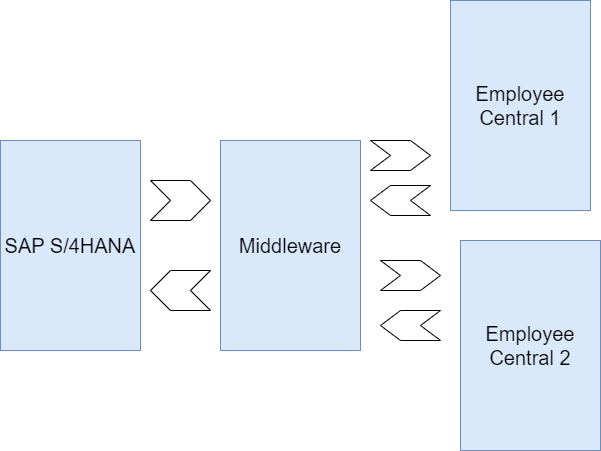
2023-12-13 21:36:27 Author: blogs.sap.com(查看原文) 阅读量:8 收藏
Context:
In response to the dynamic nature of modern business environments, the evolving requirements for integrating Employee Central instances with ERP clients now emphasize a heightened level of flexibility. Originally centered around connecting a single Employee Central instance to a corresponding ERP client for downstream processes, the paradigm has shifted to cater specifically to customers such as conglomerates and service providers.
In the context of Public Sector service providers delivering diverse services, such as Payroll through SAP HCM and other HR functions via SuccessFactors Employee Central, the requirement arises for different Employee Central entities which have specific business processes based on different legal entities. However, there is a need for a unified Payroll system, as the payroll processes remain consistent across all entities within a specific government.
For conglomerates (as one of the examples) with different legal entities, each harboring unique business processes, the current approach requires the use of separate Employee Central instances. This facilitates a tailored management of employee and organizational data, aligning with the specific needs of individual legal entities. Despite this segmentation, a cohesive strategy is required to connect these instances to the same ERP client, ensuring the seamless execution of shared processes such as benefits, tax, and payroll.
Another notable application of this flexible model arises during pivotal corporate events, such as mergers or splits. In such scenarios, the preference is to maintain separate Employee Central instances for an interim period. This strategy affords customers the operational dexterity to navigate transitional phases with minimal manual intervention. It provides a valuable buffer, allowing the organization to adapt gradually until all internal processes are streamlined.
This approach not only acknowledges the diversity of business operations within different organizations but also underscores the significance of minimizing disruptions during periods of change. The operational autonomy granted to each legal entity through separate instances reflects a strategic understanding of the unique requirements and compliance considerations associated with each entity.
In essence, this evolving integration strategy not only accommodates the complex landscape of conglomerate structures but also strategically positions the organization to manage change with agility, ensuring a smooth transition and continuity in critical HR and ERP functions.
How It looks currently:

How it will look with this feature:

Conclusion:
If you find the described feature intriguing and believe it aligns with your organization’s needs, we would like to invite you to share your insights with us. Your feedback will help us in refining and tailoring this setup to meet the diverse scenarios and requirements of our customers. By reaching out to us, you contribute to the ongoing improvement and optimization of our services.
Please consider sharing details on the specific scenarios you are planning to use with this feature. Your input will assist us in gaining a deeper understanding of your use cases, allowing us to enhance the feature to better suit your organization’s unique needs.
Feel free to contact us through the comment section, and we look forward to hearing more about your requirements and expectations. Thank you for your collaboration and for being an essential part of our ongoing development process.
如有侵权请联系:admin#unsafe.sh